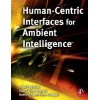- Obecnie brak na stanie



To create truly effective human-centric ambient intelligence systems both engineering and computing methods are needed. This is the first book to bridge data processing and intelligent reasoning methods for the creation of human-centered ambient intelligence systems. Interdisciplinary in nature, the book covers topics such as multi-modal interfaces, human-computer interaction, smart environments and pervasive computing, addressing principles, paradigms, methods and applications.
This book will be an ideal reference for university researchers, R&D engineers, computer engineers, and graduate students working in signal, speech and video processing, multi-modal interfaces, human-computer interaction and applications of ambient intelligence.
Hamid Aghajan is a Professor of Electrical Engineering (consulting) at Stanford University, USA. His research is on user-centric vision applications in smart homes, assisted living / well being, smart meetings, and avatar-based social interactions. He is Editor-in-Chief of "Journal of Ambient Intelligence and Smart Environments", has chaired ACM/IEEE ICDSC 2008, and organized workshops/sessions/tutorials at ECCV, ACM MM, FG, ECAI, ICASSP, CVPR.
Juan Carlos Augusto is a Lecturer at the University of Ulster, UK. He is conducting research on Smart Homes and Classrooms. He has given tutorials at IJCAI'07 and AAAI'08. He is Editor-in-Chief of the Book Series on "Ambient Intelligence and Smart Environments" and the "Journal of Ambient Intelligence and Smart Environments". He has co-Chaired ICOST'06, AITAmI'06/07/08, and is Workshops Chair for IE'09.
Ramón López-Cózar Delgado is a Professor at the Faculty of Computer Science and Telecommunications of the University of Granada, Spain. His research interests include speech recognition and understanding, dialogue management and Ambient Intelligence. He is a member of ISCA (International Speech Communication Association), SEPLN (Spanish Society on Natural Language Processing) and AIPO (Spanish Society on HCI).
Preface; Face to face collaborative interfaces; Computer vision interfaces for interactive art; Ubiquitous gaze: Using gaze at the interface; Exploiting natural language generation in scene interpretation; The language of action: A new tool for human-centric interfaces; Robust speech recognition under noisy ambient conditions; Speaker recognition in smart environments; Machine learning approaches to spoken language understanding; The role of spoken dialogue in user-environment interaction; Speech synthesis in ambient intelligence environments; Tangible interfaces for ambient augmented reality applications; Physical browsing and selection: Easy interaction with ambient services; Non-symbolic gestural interaction for ambient intelligence; Evaluation of multimodal interfaces for ambient intelligence; New frontiers in machine learning for predictive user modeling; Games and entertainment in ambient intelligence environments; Natural and implicit information seeking cues in responsive technology; Interaction in intelligent environments; Deploying context-aware home health technology: Human-centric challenges; Epilogue: Applications outlook
Brak towaru
Brak towaru
Filament firmy ROSA3D wykonany z wysokiej jakości granulatu PET-G. Na szpuli nawinięte jest 0,8 kg filamentu o średnicy 1,75 mm. ROSA3D PET-G Standard Black
Brak towaru
Miniaturowy, zdalnie sterowany robot (Mini R/C Battle Robot) z pilotem RC 2,4GHz, ładowarką i sygnalizatorami świetlnymi. Kolor czarny.
Brak towaru
Precyzyjne bity STHOR 65498 wykonane ze stali CrV 6150, z frezowanym profilem, piaskowanym wykończeniem i powłoką antykorozyjną, idealne do dokręcania i wykręcania wkrętów lub śrub. Sthor-65498
Brak towaru
Brak towaru
Brak towaru
Brak towaru
Brak towaru
Brak towaru
Brak towaru
Brak towaru
Zestaw uruchomieniowy z mikrokontrolerem STM32F103ZE (512KB Flash, 64KB SRAM, 72 MHz) i wyświetlaczem TFT 2,4\'\'. Płytka wyposażona jest w interfejsy USB, CAN, RS-232 i gniazdo na kartę micro-SD
Brak towaru
Skaner laserowy wykorzystujący technologię ToF. Wykonuje pomiary z częstotliwością od 5 do 13 obrotów na skundę i ma zasięg do 12 m. Waveshare DTOF LIDAR LD19
Brak towaru
Brak towaru
Brak towaru

